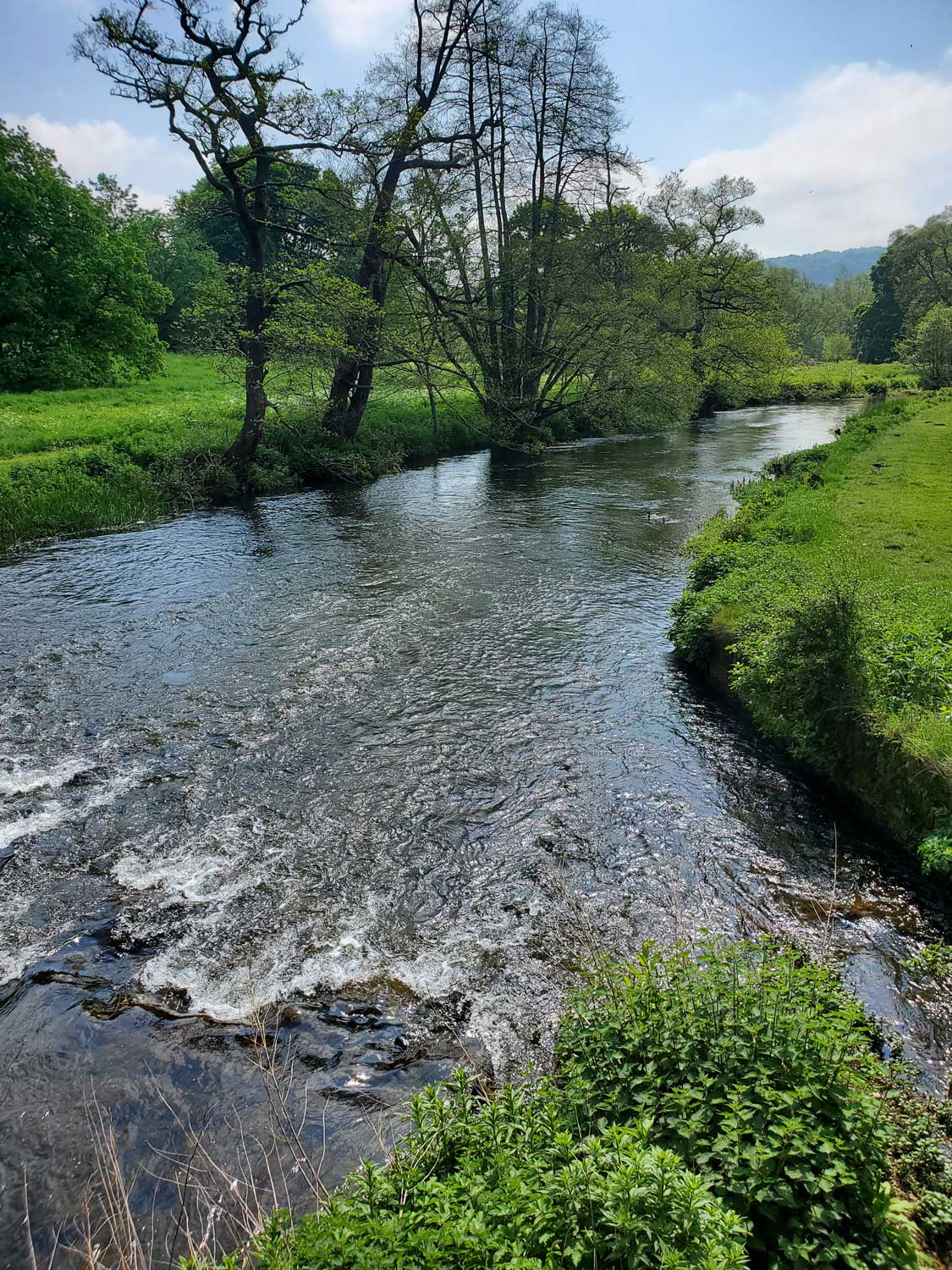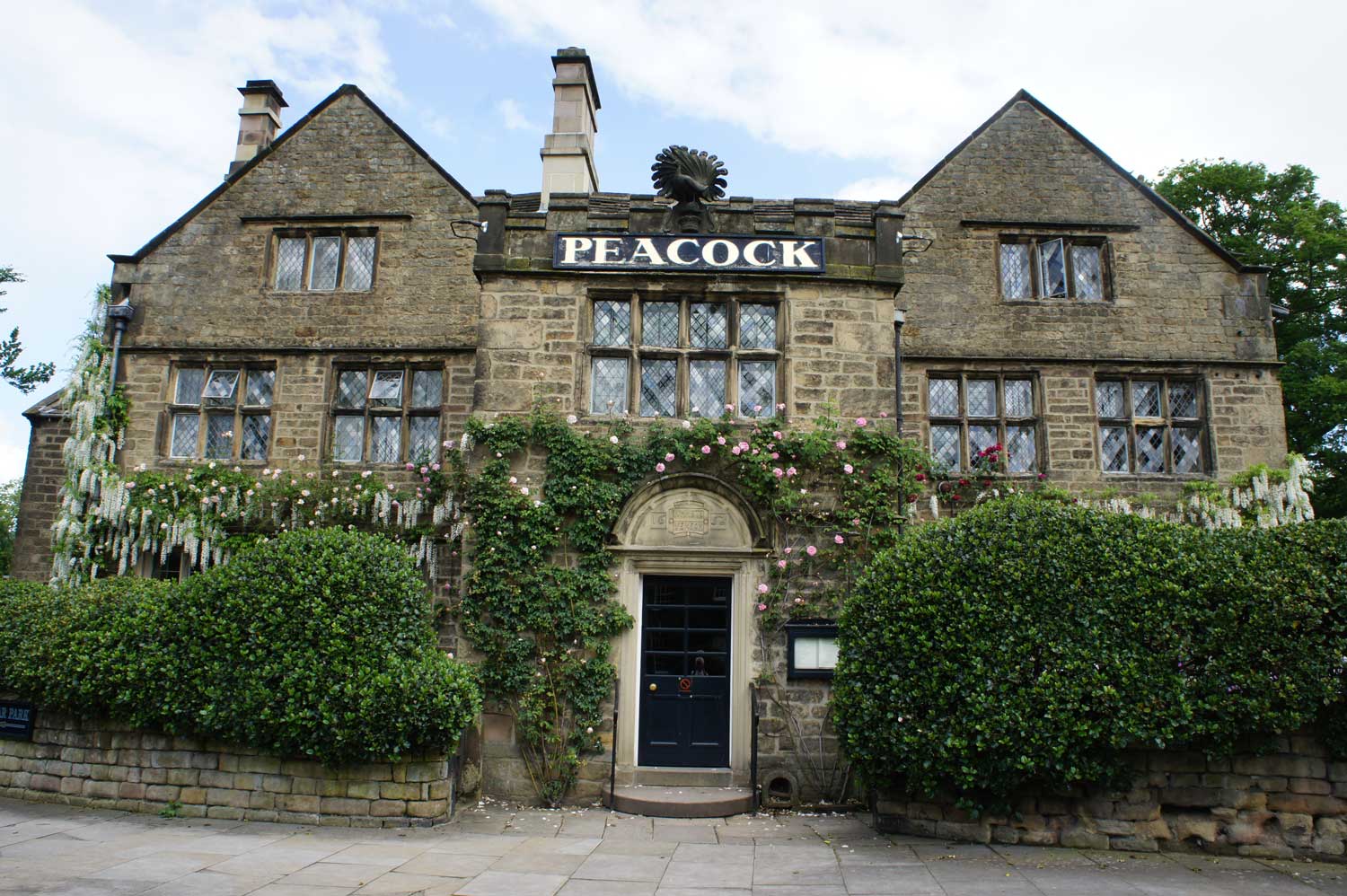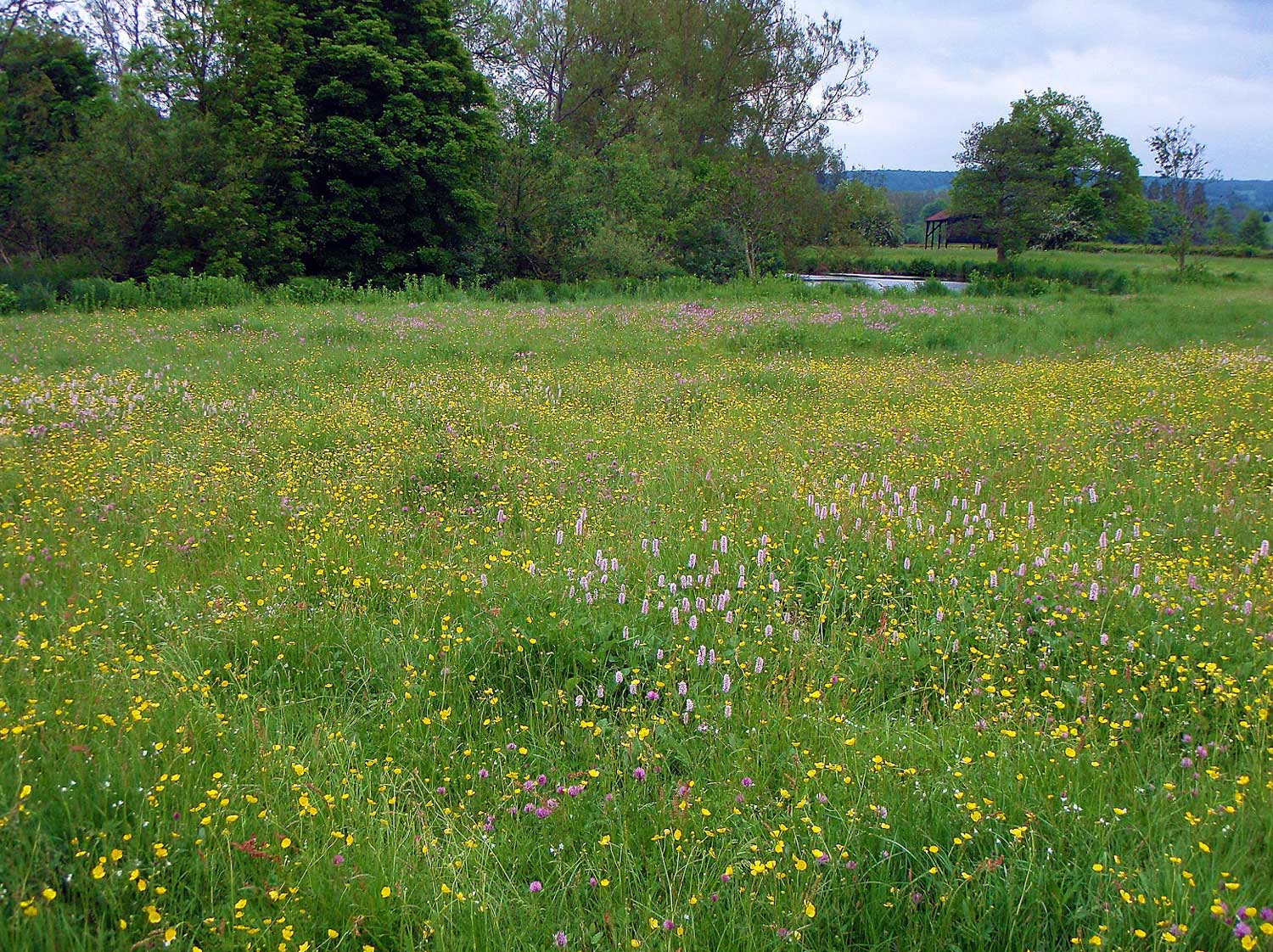Not far from the dirt path was a field thick with wide stalks of dark green, calf-high grass. To get a glimpse of the sun, wildflowers in nearly every hue—soft purple and blue, vibrant orange, pale yellow and others—poked their way through the dense carpet. Everyone and everything in the Derbyshire Valley welcomed the warm spring day. The sun’s warmth made the recent stretch of cold, wet, gray days seem like a distant memory, and the smell carried on the soft winds was clean.
Angela and Glen followed the cut path that ran along the River Wye, but I waded through the dew-soaked stalks. I was distracted; I was in search of the gaudy-colored rooster pheasant that Angela spotted. He must have been quite a tall bird, a hard flier that presented gunners standing in the fall pegs a shot challenging enough to cause a miss. Cackles from across the river came from other missed birds and, when I turned to listen to the joyful chorus, I realized how far afield I had strayed.

I caught up to Glen and Angela by the water’s edge. There in front of them was one of the prettiest pieces of water I had ever seen, and it looked quite different from any of the Eastern or Western rivers I fished back home. It did not seem that heavy flows from early season run offs, torrential rains or surges from tailwater releases were common, and I wondered if the River Wye had ever overflowed its banks? If it did, then I suspected it might have been a long time ago.
Glen looked under the tangle of branches above the slow water along the opposite bank and studied the bumbling water next to the seams. Just then, as if on cue, a trout broke the surface and took a mayfly.
“Sippers,” he said. “Tiny flies. To catch these fish, we’ll have to go very small.”
 A glance in his box revealed flies small enough to make me wish for a second pair of reading glasses. He chatted to himself, almost having a conversation about which fly would work best. Out came a CDC No Hackle emerger tied with a burnt orange tuft and a gold tinsel body. Once upon a time I fished tiny No Hackles on a regular basis but, once I moved to the coast, I focused my attention on 3/0 streamers tied on 25-pound mono if not wire. That tippet was so fine that I figured a hard look would break it in two.
A glance in his box revealed flies small enough to make me wish for a second pair of reading glasses. He chatted to himself, almost having a conversation about which fly would work best. Out came a CDC No Hackle emerger tied with a burnt orange tuft and a gold tinsel body. Once upon a time I fished tiny No Hackles on a regular basis but, once I moved to the coast, I focused my attention on 3/0 streamers tied on 25-pound mono if not wire. That tippet was so fine that I figured a hard look would break it in two.
“We’re in between big fly hatches, so we’ll stick with the small flies,” he said. “It’ll be a regular Duffer’s Fortnight in a few weeks.”
“What’s that?”
“It’s the 14-day time when the water warms and the big mayflies start to hatch. The trout and grayling go mad, and rank beginners catch trout so big they become heroes overnight.”
“That’s like our Drakes, Green, Brown or Golden.”
“Right. People catch lots of brownies and rainbows, and some of them are right proper. A lot of fishermen also come here to the Wye because it’s the only river in the U.K. that has a wild population of rainbows. You can catch a brownie, a rainbow and a grayling all in the same day and they’re all wild.”
Another trout came up on cue, then another, and a third. The hatch was picking up, and though it wasn’t the kind of blizzard they’d have in a few weeks, it brought enough fish to the surface that a refusal simply meant retargeting a different fish. On my third dead drift, the fly disappeared.

It was a small fish, one that wouldn’t bend the rod or make the reel drag scream. But it was a wild fish, and a rainbow at that. The size of the fish in hand was all of about four American inches. He was marked with aristocratic shades of pink, yellow, blue, silver and black, and that trout, though small, spoke volumes. He talked about the health of the stream, the cleanliness of the environment and the fertility of the water. There had to be bigger fish around, we just needed to find them. Glen Pointon had been fishing this water for more than two decades and, as head guide, he knew where to look.
Pointon is a modern Renaissance man. He is a highly sought-after guide, a writer, the producer and star of fly-fishing films and an ambassador for Wychwood, the famous British fly-fishing brand. He’s married, has two daughters and started a catch-and-release net company called Living the Dream Fly Fishing. Of all the rivers he guides on and fishes, the River Wye is probably his favorite.
“The River Wye is unlike any other in England,” he said. “It’s one of the few rivers in the U.K. that can sustain a dry fly-only rule because it’s so heavily populated with wild trout. That’s the result of excellent water quality returning huge amounts of hatches all the way through the season. Our season runs from March through October, and the fishing is good throughout that entire time. Flies come off even in the heat of the summer or the depths of winter.”
We walked downstream and passed through an open double-cross field gate just up from the warming shed. In the slow water on the opposite side of the river, a brown trout came up. He came up again but disappeared when a mallard drake and hen swam upstream. No sooner than they had gone, he started rising again.
“He’s a better fish,” said Glen. “He’s consistently coming up.”
I cast on the edge of the grass that hung over the river and he ate. This fish put a little bend in the rod, and he was double the size of the rainbow. And then for a while it seemed that every next fish was slightly larger than the previous one. Never leave fish to find fish, but that’s just what we did. We could do that easily enough with a walk upriver.

The town of Rowsley, you see, is somewhat of the epicenter for Derbyshire trout fishing. It’s in the middle of a 1,000-year-old, 3,800-acre Haddon Hall and is a country estate owned by Lord and Lady Edward Manners. Our hotel, the Peacock at Rowsley, originally built in 1652 for the steward of Haddon Hall, has been a hotel for discerning travelers since 1832. There are 15 guest rooms, a dining room and a comfortable bar that serves local ales and an award-winning restaurant serving meals procured from local meats and produce. Included in an overnight is a day of fishing not just on the River Wye but also on three other limestone rivers that run through the estate: the Rivers Derwent, Lathkill and the Bradford. Day passes can be purchased for anglers travelling through, and fishing can be self-guided or guided. For those who live in the U.K. or are frequent visitors, membership to the Peacock Fly Fishing Club may be a good idea (there are 21 miles of rivers to fish). The Peacock Hotel sits on the River Derwent near the confluence with the Wye, which makes for impossibly easy access. To mail a postcard home or to secure an evening bottle of wine or spirits for your room, just visit the post office next door, they can accommodate both.

The stretch of the Wye that we fished is 7.5-miles long and originates as a small stream at Axe Edge above Buxton. The stream flows east through gorges, woodlands and past farmers’ fields full of either dairy cows or sheep. It meanders its way through a more populated section around the quaint town of Bakewell, flows underneath a footbridge complete with Gothic arches, and skirts the edge of a cricket and croquet pitch. The more pastoral setting is downstream and runs through Lord Manners’ home, Haddon Hall castle. The historical property is open for public tours, making a fishing trip and a castle garden tour wonderfully easy.

Part of what makes the Derbyshire section of the Wye so special is that the river washes through the limestone in the stream bed. The mineral buffers the water to a perfect pH, and its health is easily visible through diverse hatches of mayflies, caddisflies, midges and crustaceans. Consistent flows with stable temperatures make the water clean, cold and crystal clear. Trout spotting, too, is a wee bit easier.
Another part is that the Wye is the only river in the U.K. to support a population of wild rainbows. Shipments of fertilized eggs from a Baha, California, strain of rainbows began arriving in the Peak District from a New York State hatchery as early as 1885. Some of the rainbow fingerlings were stocked in Ashford Lake above Bakewell and they quickly assimilated to their new home. But then an act of God in the form of a massive, early 1900s flood, wiped out the dam and ruined the lake fishing. Thankfully, all was not lost, for these stocked rainbows entered into the River Wye near Ashford. They didn’t just survive in the healthy river system; instead, they thrived. For the past century, these rainbows have been naturally reproducing and are as wild as if they were native. The wild rainbows on the River Wye make a wild fish hat trick of browns, rainbows and grayling an intoxicating possibility.

But of greater importance to me was the river’s strong reputation as a wild trout stream. In an age of game stocking of all kinds, the visionary pair of Lord Edward and his riverkeeper, Jan Hobot, have focused on wild and natural everything.
“What drew me to this estate more than two decades ago was the fact that the family wanted to promote wild fish in healthy rivers and river corridors,” Hobot said. “But that wasn’t always the case. Up until about 2003, Haddon Estate had been stocking not just the Wye, but also the Derwent, Lathkill and Bradford. The riverkeepers built the case for switching to the wild and natural fishery by studying how raised fish interacted with wild fish. Their research showed that it wasn’t very good.

“My predecessors noted that the wild fish became nervous and quivered immediately after a stocking. Their feeding became interrupted, they were pushed out of their lies and, since the stocked interlopers typically were fed twice daily, there was a competition for food. Wild fish need to learn to survive from the moment they hatch from their eggs. They need to work up the hierarchy to get to prime lies and feeding positions. The addition of stocked fish caused the quality of sport to decline to the point where we had to decide what kind of fishery we wanted to develop.
“For the past 20 years we have worked as a 100-percent wild fish fishery. It has taken a tremendous amount of work, but it’s been rewarding. Recently we’ve found that other properties and companies are sharing our ethic. Companies such as Patagonia and Yeti share our vision for wild fish and have been supporting our efforts as partners. As word spreads, I’m hopeful that other companies and riverkeepers will work to improve the health of their rivers and systems, too.”
Anyone who visits the River Wye will benefit from Hobot’s work that constantly improves water quality and habitat. The high-quality fishing experience is the result of a number of large-scale projects that occur every year.
“To create a healthy ecosystem, you have to remember that fish live in trees,” Hobot said. “That means they find safety and security holding among the deadfall. But there is more to creating holding lies than to simply fell trees into the river. I have to consider the impact that cut trees will have on the entire river. It will alter flows which can wash around riverbeds and the like. Once I figure all of that out, I may coppice willows, create faggots and sometimes reroute the river so the current will clean up problems that likely began more than a century ago during the Industrial Revolution. Right now, I’m in the process of removing a historic weir, or fish trap. Once that is gone, I can import gravel for use in creating new spawning grounds.

“My team and I sample water every month and monitor levels of ammonia, nitrates and phosphates. If we find any pollutants, then we can act immediately before there is a major problem. Our efforts have paid off, for in the past 12 months we have shown that we have ‘good ecological status’ on all of our rivers, which is fantastic news.
“We also do monthly kick samples on all the rivers to survey our invertebrate life. As most anglers know, invertebrates are the first to suffer from poor water quality. The excellent quality of water in the River Wye means we have a good number of invertebrates. This is especially important as we run a dry fly-only fishery on three of our other rivers.”

Photo courtesy: Richard Ward
Hobot and his team routinely cut margins and paths and do plenty of strimming to make accessing the river easy. “Usually while we’re cutting the grasses we look to remove any invasive species growing around the river. Himalayan balsam, Japanese knotweed and giant hogweed threaten the native species, so we have to be vigilant. And since we do not stock fish, we pay attention to poachers.”
Rules help keep the river pristine and the fishing its very best. In keeping with a wild trout fishery, catch-and-release is a requirement. Using barbless hooks minimizes injury to released fish. No wading is allowed, making Wellington-style boots the preferred choice for walking the banks. And the most important rule is that fishing is dry fly-only. Prospecting is allowed so anglers don’t need to cast only to rising fish. But because of the significant insect life, hatches of some type are a daily occurrence. Also, flies cannot swing below an angler’s position. All casts must be upstream.

Jan Hobot, the River Wye’s visionary riverkeeper, has a goal of creating self-sustaining, wild trout fisheries.
To see another part of the river we walked upstream past the garden allotments filled with early rhubarb. We caught a few browns in the stretch behind the cricket pitch and worked our way up to the village of Bakewell. There aren’t many places I know where you can catch trout and then walk into a Medieval village, but Angela took a break and did just that. Her goal for us was a taste test of sorts, one that involved a sampling of pastries unique to the village. She returned with Bakewell tarts, delicious short-crust pastries filled with jam and almond cream, and we compared them with the Bakewell pudding, which has similar ingredients but is baked in a puff pastry.
While chatting about the merits of each, we met a cheerful man with a fly rod. If Wardy was his call name, then Richard Ward was his registered name, and Wardy was a member of the Peacock Fly Fishing Club. He joined several years ago because the fishing club afforded him a place to wet a line.
“I’ll fish the Wye just about every day,” he said. “It’s very close to home.”
“It’s nice to have a short drive to go fishing,” I said. “That makes things easy.”
“Oh, I don’t have to drive,” he said and pointed his rod to a general area upstream. “I live over there. See that house on the left with the yard that meets the river? That’s where I live.”
Crikey, Wardy just redefined the term “home waters.”
There are three River Wye’s in the U.K. One is 185 miles long and runs between England and Wales. The second is an 11-mile stretch near the poet William Wordsworth’s home in the Lake District. But do get to this third River Wye in Derbyshire. Here’s how you do it—fly into Heathrow, take the tube to St. Pancras International train station and stay in the adjacent St. Pancras Hotel. After a full English breakfast, take the East Midlands Railway to Derby, which is on the River Derwent. Rent a car and then drive north through small villages and their architecture from a variety of periods including Elizabethan, Victorian, Norman and Arts and Crafts movement. And when you arrive, have a pint of bitters for me. After driving on the side of the road opposite ours you’ll both want and need one.

